Last updated on May 21, 2025
How to Write a Novel: A Bestselling Author’s Guide
Tom Bromley
Author, editor, tutor, and bestselling ghostwriter. Tom Bromley is the head of learning at Reedsy, where he has created their acclaimed course, 'How to Write a Novel.'
View profile →Writing a novel is an exhilarating challenge. How do you transform a simple idea into a powerful narrative that grips the reader from start to finish?
I’ve spent over 25 years in publishing — acquiring books for Little, Brown, founding Pavilion's Portico imprint, writing novels and memoirs for Big Five publishers, and ghostwriting international bestsellers. Since my debut novel Crazy Little Thing Called Love in 2002, I've also guided thousands of writers, including through Reedsy’s flagship course, How to Write A Novel.
There’s no one way to write a novel. One of my favorite books on the craft — Patricia Highsmith’s Plotting and Writing Suspense Fiction — isn’t prescriptive: “This is how I do it,” she says, “but your way may be different.” That’s the spirit I bring here — what I’ve learned through decades of writing, editing, and teaching. I hope you find it useful.
How to write a novel in 8 steps:
1. Choose a compelling story idea
Every story starts with an idea.
You might be lucky, like JRR Tolkien, who was marking exam papers when a thought popped into his head: ‘In a hole in the ground there lived a hobbit.’ You might be like Jennifer Egan, who saw a wallet left in a public bathroom and imagined the repercussions of a character stealing it, which set the Pulitzer prize-winner A Visit From the Goon Squad in process. Or you might follow Khaled Hosseini, whose The Kite Runner was sparked by watching a news report on TV.
Ideas come in all shapes and sizes: they can appear when you least expect them, so making a note is important. One writer claims that if you don’t write an idea down in five minutes, you’ll forget it. I don’t know if that is true, but it’s a good maxim to have in mind!
Most novelists I know keep a notebook of ideas both large and small — sometimes the idea they pick up on they’ll have had much earlier, but for whatever reason, now feels the time to write it. Certainly, the more ideas you have, the more options you’ll have to write.
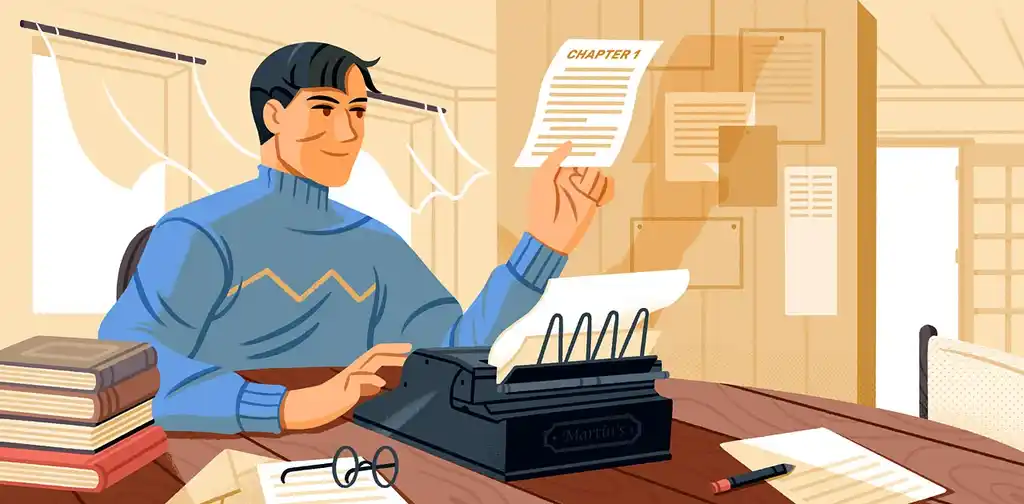
FREE COURSE
How to Write a Novel
Author and ghostwriter Tom Bromley will guide you from page 1 to the finish line.
🎓 In practice: For my debut novel, the starting point was music. I played in a number of bands at school and college and tried to make it big after university (plot spoiler: we didn’t). I was the least rock and roll member of the group, so while everyone else got up after midday, I used my mornings to write. And starting with that premise of ‘write what you know’, I decided to write a romantic comedy based around being in a band.
At the time, there weren’t many books about making music, and from my own experiences, I thought it was a rich comic seam to mine. That was the starting point from which the story developed.
Q: What's the best piece of writing advice for an author who wants to improve their craft?
Suggested answer
Join critique groups! These were invaluable to me when it I started writing and even taught me how to edit! Reading books will become dated with old advice, so stay up to date with blogs, trends, audiences, and read, read, read!
Stephanie is available to hire on Reedsy ⏺
Practice and read!
In the same way that you need to practice a musical instrument to get better, you need to do the same with writing too. Very few writers will publish the first book they ever write!
The other thing that will help you to improve your writing craft is reading. Read the books that are selling well in your genre right now, not just the bestsellers from a decade ago. Study them. Look at the reviews for these books and listen to what readers are saying.
There are loads of brilliant books that will help you to write an effective novel as well (Into the Woods by John Yorke, The Science of Storytelling by Will Storr, Story Genius by Lisa Cron and Save the Cat Writes a Novel by Jessica Brody are a few of my favourites). Even if you don't agree with everything they say (I don't necessarily agree with every piece of advice in the above!) it's so helpful to see a range of different perspectives. You'll also quickly be able to see the patterns and advice from these books in the bestsellers you read. There are also loads of podcasts, blog posts, YouTube videos and audiobooks out there too, as well as Reedsy's own masterclasses!
Sian is available to hire on Reedsy ⏺
✍️ Your turn: Many novel ideas, like Jennifer Egan’s A Visit From The Goon Squad, start small and expand out. Rather than searching for the big idea, begin with smaller ones and write those out. If there’s a novel in it, you’ll feel it.
I've talked in more detail about how to generate great story ideas in the Reedsy Live below.
2. Develop memorable characters
Different people will tell you that character or plot are the most important element when writing. In truth, it’s a bit more complicated than that: in a good novel, the main character or protagonist should shape the plot, and the plot should shape the protagonist. So you need both core elements in there, and those two core elements are entwined rather than being separate entities.
Characters matter because when written well, readers become invested in what happens to them. You can develop the most brilliant, twisty narrative, but if the reader doesn’t care how the protagonist ends up, you’re in trouble as a writer.

As we said above, one of the strengths of the novel is that it gives you the space to show how characters change over time. How do characters change?
Firstly, they do so by being put in a position where they have to make decisions, difficult decisions, and difficult decisions with consequences. That’s how we find out who they really are. Secondly, they need to start from somewhere where they need to change: give them flaws, vulnerabilities, and foibles for them to overcome. This is what makes them human — and the reason why readers respond to and care about them.
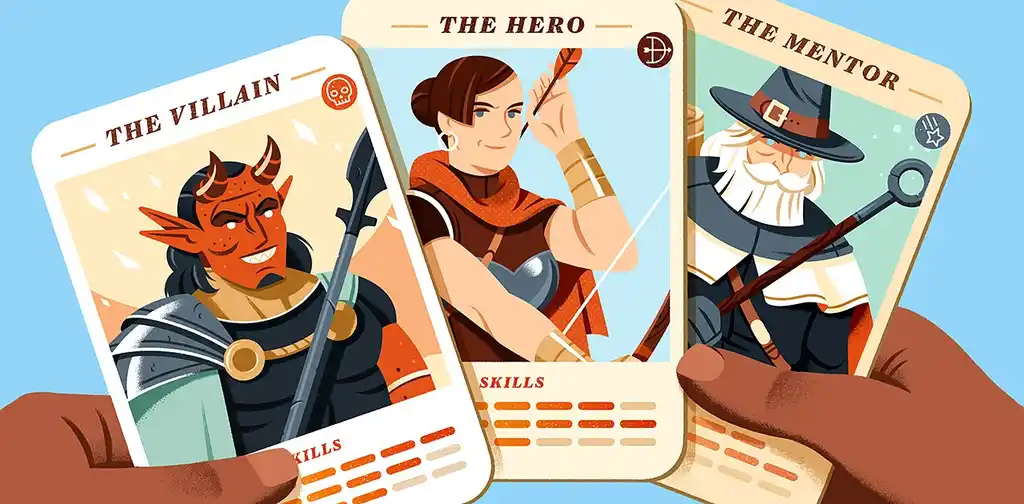
FREE RESOURCE
Reedsy’s Character Development Template
A story is only as strong as its characters. Fill this out to develop yours.
🎓 In practice: The protagonist in my debut novel, Will, is the bass player in the band. He is taking a gap year before university, which is when he joins the group. He is young and inexperienced, and the book has a coming-of-age element to it. The starting point to his character was very much myself and my own awkwardness and insecurities when I was eighteen. That was unfortunately – fortunately? – another rich seam to mine!
Q: What are effective adjectives for describing characters, and when should each be used?
Suggested answer
My favourite from my writing has been "etiolated." It's a word that describes a seedling starved of sunlight - thin and pale and reaching up. It contains a lot of layers of imagery which were useful for describing a character at their lowest point.
Mairi is available to hire on Reedsy ⏺
Curious, rebellious. A character that doesn't quite "fit the mold" will usually be interesting to readers.
Melody is available to hire on Reedsy ⏺
Characters are best described through body language and dialogue. Avoid overusing adjectives and let your readers do some of the interpreting. There is no need to spell everything out for them. The best way to convey a character's personality is through action, dialogue and body language.
Eva maria is available to hire on Reedsy ⏺
The other main characters I developed through a combination of people I knew, people I knew about and my imagination. For each (this was very early Internet days), I went through newspapers and magazines to find pictures that I thought reflected who they were. I then cut these out and stuck on separate pieces of paper as aides-mémoire as I wrote.
✍️ Your turn: For your characters, think about three things. What drives them? What are their flaws? And why should we, the reader, care about what happens to them? If you can answer those questions, you’re well on the way to creating memorable characters.
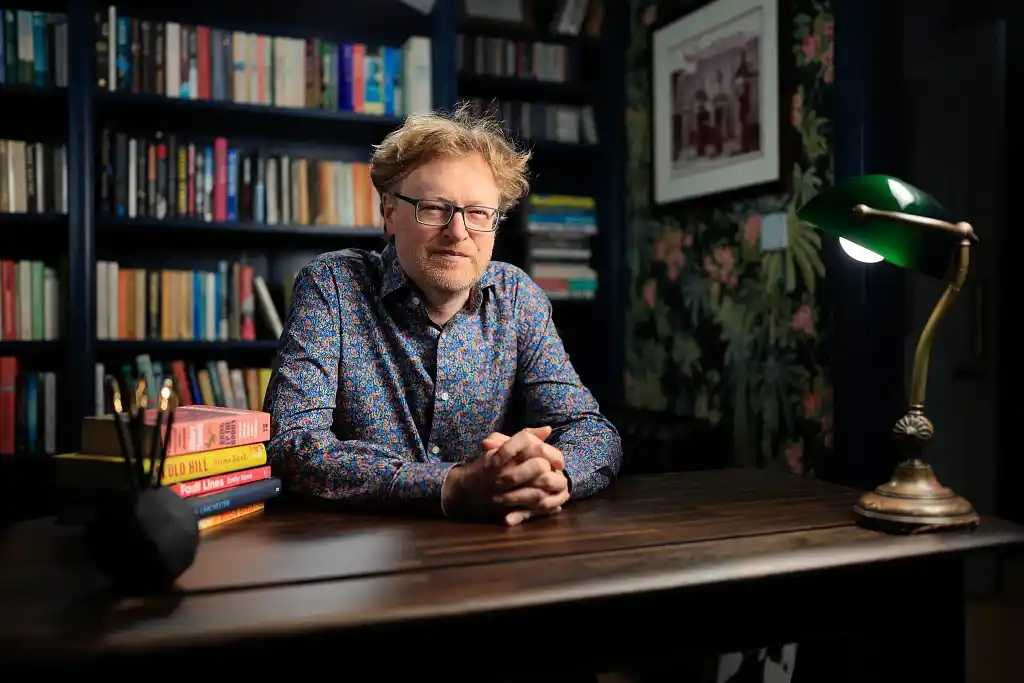
3. Define conflict and stakes
The drama in the novel is usually built around some sort of central conflict. This conflict creates a dramatic tension that compels the reader to read on. They want to see the outcome of that conflict resolved: the ultimate resolution of the conflict (hopefully) creates a satisfying ending to the narrative.
Conflicts come in many types, but in two main forms: external and internal. External conflict is one between the protagonist and an antagonist of some sort — be it a rival lover, a fire-breathing dragon, or an oppressive system. Internal conflict is where the focus of the struggle is within that individual — the struggle of competing life choices, say, or overcoming addiction. That might not sound as dramatic, but written well, internal conflict can often be even more powerful.
A character changes, as we said above, when they are put in a position of making decisions with consequences. Those consequences are important. It isn’t enough for a character to have a goal or a dream or something they need to achieve (to slay the dragon): there also needs to be consequences if they don’t get what they’re after (the dragon burns their house down). Upping the stakes heightens the drama all round.

🎓 In practice: With my first novel, the central tension revolves around the protagonist Will, the band’s lead singer (Rich), and Rich’s photographer girlfriend (Lauren). In a Cyrano de Bergerac style, Will writes the band’s lyrics, based on his feelings for Lauren. Rich then pretends he has written the lyrics, cementing Lauren’s feelings for him. Will knows that if he reveals the truth, he’ll be kicked out of the band just as they become successful. But if he stays, he’ll have to watch Rich and Lauren together. He faces difficult decisions, and decisions with consequences to make.
✍️ Your turn: What might the conflict at the heart of your book be? Try to think of one external and one internal for your protagonist. Which feels the stronger driver for your narrative?
4. Build a vivid setting
The next element to consider before beginning your story is to think about where your story is going to be located. Settings play a surprisingly important part in bringing a story to life. When done well, they add in mood and atmosphere, and can act almost like an additional character in your novel.
There are many questions to consider here. And again, it depends a bit on the demands of the story that you are writing. Is your setting going to a real place, a fictional one, or a real place with fictional elements? Will it be set in the present day, the past, or at an unspecified time? Are you going to set your story somewhere you know, or need to research to capture it properly? Also important to consider for setting is when your story is going to be set: is it in the present day, the past or the future?
If you’re writing a novel in genres such as fantasy or science fiction, then you may well need to go into some additional world-building as well before you start writing. Here, you may have to consider everything from the rules and mores of society to the existence of magical powers, fantastic beasts, extraterrestrials, and futuristic technology. All of these can have a bearing on the story, so it is better to have a clear setup in your head before you start to write.
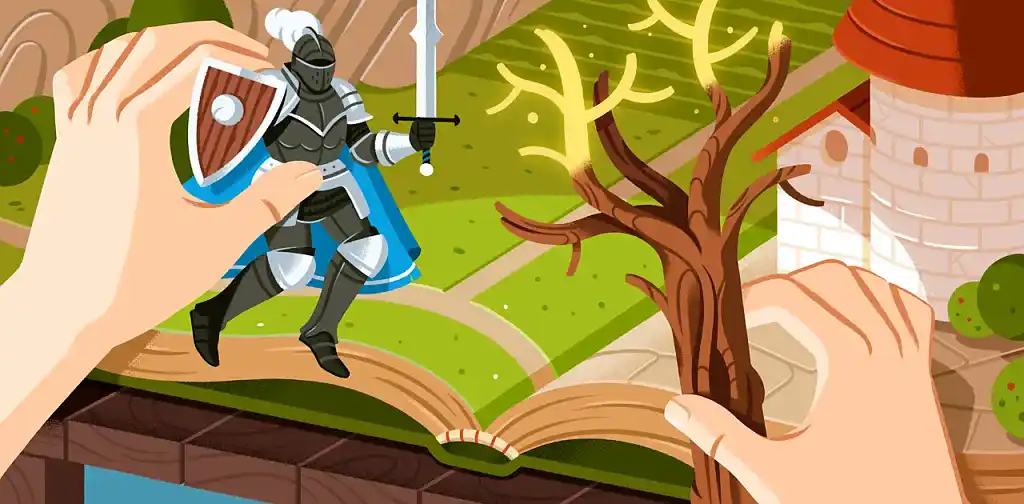
🎓 In practice: For my novel, I wanted it to be based in a British city outside of London and settled on Brighton, which is the sort of cool, hip place where a new music scene could happen. Apart from the occasional trip to the seaside, I didn’t know Brighton very well, so I undertook several research trips to the city.
Again, this was in pre-Internet days, but although now you could do much of the research online, there was something important about walking the streets, finding the pubs, venues, cafes and parks where the book was set. I visited residential roads until I found a house that could have been where Will lived, taking a few surreptitious photos for reference! That helped ground the book for me, and also get into the protagonist’s character.
✍️ Your turn: Sketch out some possible settings for your story. If they’re real, can you visit or research them? If they’re invented, can you describe what makes them distinct? A useful exercise can be to draw a map of the place where your novel is set. The more information you can include, the richer your setting will be.
5. Decide on the point of view
Another important decision to make before you start putting pen to paper (or finger to keyboard) is to think about which point of view you’re going to tell your story from. It is worth thinking about this before you start writing because deciding to change midway through your story is a horribly thankless task (I speak from bitter personal experience!)
Although there might seem to be many viewpoints you could tell your story from, in reality, most fiction is told from two points of view — first person (the ‘I’ form) and third person ‘close’ (he/she/they). ‘Close’ third person is when the story is witnessed from one character’s view at a time (as opposed to third person ‘omniscient’ where the story can drop into lots of people’s thoughts).
Both of these viewpoints have advantages and disadvantages. First person is usually better for intimacy and getting into the character’s thoughts: the flip side is that its voice can feel a bit claustrophobic and restrictive in the storytelling. Third person close offers you more options and more space to tell your story: but can feel less intimate as a result.
There’s no right and wrong here in terms of which is the ‘best’ viewpoint. It depends on the particular demands of the story that you are wanting to write. And it also depends on what you feel most comfortable writing in.
I dive deeper into narrative point of view in this video excerpt from my How to Write a Novel course — starting at 4:18.
🎓 In practice: For my debut novel, I felt that first person was the better fit for the story I wanted to write. That’s what I started with and went on to stick with. If I had been more experienced, I would have tried different viewpoints. With my next novel, I experimented with a different setup – I tried both first and third person, and also used letters and emails to bring in different voices. In the end, I used a combination to make the book work.
✍️ Your turn: It can be a useful exercise to write a short section in both viewpoints to see which feels the best fit for you before starting to write. You might want to consider experimenting with tense as well before you start writing.
6. Plan your plot structure
When you first start writing a novel, perhaps the single biggest element to get your head around is how to structure your book. I began my writing journey by working on short stories: that can help teach you about all sorts of writing elements. but it’s only when you begin work on a novel that you can get a sense of what structuring a novel is all about.
There’s no right answer as to how much planning you should do before you start to write: it very much depends on the sort of writer you are. Some writers find planning out their novel before start gives them confidence and reassurance knowing where their book is going to go. Others find this level of detail restrictive: they’re driven more by the freedom of discovering where the writing might take them.
This is sometimes described as a debate between ‘planners’ and ‘pantsers’ (those who fly by the seat of their pants). In reality, most writers sit somewhere on a sliding scale between the two extremes. Find your sweet spot and go from there!
🎓 In practice: My own experience with my first novel was to go back to books I knew and loved and work out how the plots worked in those. I’d try and summarise each onto a single sheet of A4 with lots of arrows and circles and work out how to plot through that. That might have been a longer way round than following the formula of one of the plot books, but it helped teach the secrets of what a narrative is made up of.
I then spent a long time with index cards, writing out the different chapter summaries and laying them out on the floor. I found something really useful in being able to see the book visually.
Finally, I drew on real-life events to pull the timeline together, including the death of Freddie Mercury (November 1991), an unsigned band festival called Sound City (April 1992), and a famous rave at Castlemorton Common (May 1992) to close the book. I found that using events gave me something to shape the narrative around.
✍️ Your turn: Choose a novel you love and see if you can plot it out on a single sheet of A4. What are the main plot points? How does the story rise and fall? What could you take away from the structure to use in your own work?
Consider these 3 plotting principles
Looking back, what I learned during the writing process was the importance of underlying plotting principles and the role of the protagonist in shaping the narrative.
The plotting principles I sometimes describe when I teach are the ‘Three C’s’ of change, causality, and complications.
- 🌊 Change is fundamental to a good story: you want your protagonist to feel a different person at the end of the book to who they are at the beginning, because of the events they go through.
- ⛓️ Causality is the sequencing of the events: each key plot point should lead onto the next, with the story only being able to be told in one particular order.
- 🚧 Complications are about making life difficult for the protagonist: the harder the choices they have to make, the more they are likely to change (see point one).
And the Protagonist’s Journey
Rather than following the traditional writing formulas, I think it is better to shape the story more specifically around the protagonist’s own motivations. The first half of a story should be around what a protagonist wants, or thinks they want; the second half should be about what they more fundamentally need. Using this idea creates an overall framework to structure the story around and one embedded in the main character. This can be described as follows:
Protagonist wants X → They search for X, realize what they really need is Y→ Protagonist searches for Y → They achieve Y.
🎓 In practice: At the beginning of the book, Will is seduced by the rock and roll lifestyle and sees it as a way to attract women. But as the novel goes on he realises that rather than casual affairs, what he really needs is to be in a proper relationship, specifically with Rich’s girlfriend Lauren.
To begin with, he wants sex: ultimately, he needs love. Knowing these underlying motivations was really important in shaping the story for me. It gave the story an underlying structure from which I was able to shape the narrative.
✍️ Your turn: Think about the motivations of your potential main character. What do they want, or think they want? And what do they need? If you can answer these questions, you’ll go a long way towards shaping your overall story.
7. Write the first draft
Having done your prep — or as much prep and planning as you feel you need — it’s time to get down to business and write the thing. Getting a full draft of a novel is no easy task, but you can help yourself by setting out some goals before you start writing.
Find a writing routine
Firstly, think about how you write best. Are you a morning person or an evening person? Would you write better at home or out and about, in a café or a library, say? Do you need silence to write, or musical encouragement to get the juices flowing? Are you a regular writer, chipping away at the novel day by day, or more of a weekend splurger?
I’d always be wary of anyone who tells you how you should be writing. Find a routine and a setup that works for you. That might not always be the obvious one: the crime writer Jo Nesbø spent a while creating the perfect writing room but discovered he couldn’t write there and ended up in the café around the corner.
You might not keep the same way of writing throughout the novel: routines can help, but they can also become monotonous. You may need to find a way to shake things up to keep going.
Q: What daily writing routines can help authors maintain consistent productivity?
Suggested answer
There are four things that I consider before settling in to write.
What sounds are there? The best is silence, but in a city environment this is impossible. If there are specific loud that I want to block out, I listen to drone music. This consists mostly of long, sustained notes (no melodies) and comes from the American and German post-war experimental musical traditions. The texture of the sounds is often rich which works for this purpose quite well. It has a meditative effect. Failing this, music without lyrics is also good.
What is my phone doing? Just switch it off.
Social media. Along with my phone, this is designed to distract. What I do is log out of my social media accounts. If I automatically go back in, I'm then met by the login page. This doesn't sound like much of a difference, but is just enough to nudge myself into becoming mindful of what I'm doing and what my present purpose it. And mindfulness is key.
Lastly, I take a page of Hemingway's advice: "The first draft of anything is s**t." It's ok to produce bad writing. In fact, it's totally ok; actually it's great. Why? Because my ideas are now down on the page, even if it's absolutely horrible. Nobody ever simply writes a finished product straight off the bat. I'll make it better later and that is a different process.
Don is available to hire on Reedsy ⏺
In my experience, writing speeds vary. I tend to start quite slowly on a book, and speed up towards the end. There are times when the tap is open, and the words are pouring out: make the most of those moments. There are times, too, when each extra sentence feels like torture: don’t beat yourself up here. Be kind to yourself: it’s a big, demanding project you’re undertaking.
Shut out your inner editor
The other important piece of advice is to continue writing forward. It is very easy, and very tempting, to go back over what you’ve written and give it a quick edit. Once you start down that slippery slope, you end up rewriting and reworking the same scene and never get any further forward in the text.
I know of writers who spent months perfecting their first chapter before writing on, only to delete that beginning as the demands of the story changed.
The first draft of your novel isn’t about perfection; it’s about getting the words down. One writer I work with calls it the ‘vomit draft’ — getting everything out and onto the page. It’s only once you’ve got a full manuscript down that you can see your ideas in context and have the capacity to edit everything properly.
So as much as your inner editor might be calling you, resist! They’ll have their moment in the sun later on. For now, it’s about getting a complete version down, that you can go on to work with and shape.
When I started writing, I was definitely a perfectionist and rewrote and rewrote that first beginning. In the end, the finished book ended up beginning in a different place, so I would have been much better just to march on with the writing!
Over the years, the more books I’ve worked on, the more confident I’ve got in giving that first draft the room to breathe. I know now how much you can change in the rewrites and that the important thing with the first draft is to get something down. As the saying goes, you can’t edit a blank piece of paper.
8. Revise and get feedback
At this point, it is useful to get some feedback on what you have written. It may be that you know some fellow writers and can offer a swap deal to look at each other’s work. Or you might find some ‘beta’ readers for your book – friends who read and whose opinion you trust. It might also be the time to get professional help – there are many editors at Reedsy who can offer a manuscript assessment.
Hire an expert
Ann Howard C.
Available to hire
Traditional-publication-focused editor with 17 yrs of experience specializing in fantasy, science fiction, suspense, and historical fiction.
Catherine L.
Available to hire
I'm a senior editor with over eleven years of experience working on picture books, middle grade and young adult books at Simon and Schuster.
Aaron L.
Available to hire
Editor in Chief of an art & lit website and English educator who loves all forms of creative writing—both poetry and prose.
Whichever approach you choose, pool the comments and take that feedback on board. My rule of thumb is that if more than one person is saying the same thing then they are probably right. For my own debut novel, I started by sharing with friends in a writing group. Then, when I got an agent, I followed his advice on further changes. And once that process was complete, I was lucky to be offered a book deal.
Q: What should clients expect in terms of feedback and revisions during a developmental edit?
Suggested answer
With a development edit, what I'm giving you is a full health check and service of your novel. This is a close, hands-on edit of your story, focusing on narrative development, characterisation, dialogue, story-telling, and the clarity of your authorial voice and your prose. Essentially, my aim is to help you get the best out of your novel and give you the best advice possible. With several decades' experience working in genre publishing, I have an excellent idea as to what markets are out there and where to best place your novel.
You can expect to receive the edited novel with my changes tracked and comments included. Through the tracked changes you will be able to see my advice on what you can change and consider in revising your novel. I always track changes, as a development edit is a collaboration with the client. I'm using my extensive experience to make judgements on what works and what doesn't, but at the end of the day you have to be happy with those changes, and that they are true to your vision for the work.
As well as the full edit, I also provide my clients with a copy of the chapter and style notes I make as I edit. These are an immediate record of my process, showing my thoughts on each specific chapter. Clients also receive an editorial table, which is what I use to keep track of the spelling of names, unusual/unique terms, and places in the novel, as well as keeping track of essential characteristics, such as hair colour. I also provide my clients with a book report. This is an overview and analysis of the novel, detailing my key findings and suggestions as to revisions the client can consider and what next best steps they may also consider.
Finally, I offer to follow up with my clients in a one hour Zoom or Skype call, which is their opportunity to ask me any further questions they may have, as well as to discuss my edits in detail.
Jonathan is available to hire on Reedsy ⏺
I define a developmental edit as a comprehensive review of a book’s strengths, weaknesses, and opportunities for revision. With your manuscript, I’d read it and consider its pacing, plot, character development, voice, and other building blocks of storytelling. After reading the draft, I’d deliver to you a detailed editorial letter (no shorter than 3,000 words). The other "deliverable" from this service would be a detailed annotation of the manuscript. Using Track Changes, I would point out in-text examples of what's working, what's not, and potential paths forward as you continue shaping the manuscript. I find that this tool can be especially helpful for authors who want specific examples identified for them throughout the text. My expectation is that these two deliverables can help you improve the current manuscript while also adding to your knowledge base long-term. Hopefully, they’ll be resources you can revisit again and again.
Kevin is available to hire on Reedsy ⏺
A nose-to-tail structural edit of your manuscript for authors who have taken their book as far as they can by themselves.
- Detailed recommendations to improve “big picture” concerns like characterization, plot, pacing, setting, etc.;
- Specific guidance on elements of writing craft;
- In-line suggestions and edits in the manuscript.
Brett is available to hire on Reedsy ⏺
A developmental edit includes an analysis of what is working and what still needs to be improved regarding big-picture issues like pacing, plot, clarity, setting, telling vs. showing, character development, etc. I provide suggestions for improvement directly on the manuscript using track changes in Word. I also include pages of editorial notes regarding what still needs to be improved and I provide suggestions on how to improve these issues. I am also always available for Zoom chats before, during, and after any edits are provided. And clients may contact me at any point in the process regarding any questions or concerns, even after the collaboration has officially ended.
Melody is available to hire on Reedsy ⏺
My developmental edits include two parts: line notes and a letter.
The line notes point out any strengths or issues that arise as I read. For full-length books, generally, these line notes will even out to about 1-2 per page, though some pages may have none, and some pages may have many, as needed. For shorter pieces and picture books, I typically include many more line notes per page, depending on what is needed. When I notice a repeated problem, I discuss it in my overall letter rather than commenting on every instance. These line notes are meant to educate authors and help them become better writers, not "fix every error" as a copy edit would.
For full-length books, for the letter, I normally include:
- An introduction discussing the book's high-level strengths and opportunities for improvement.
- Sections discussing structure/plot, character, setting/worldbuilding, romance if applicable, target market (age category, genre, and comp titles), title, and style.
- A conclusion with key next steps to focus on for the book.
These letters are lengthy, generally in the ballpark of 3,000 words (10-ish pages), and come with a table of contents.
My letters for shorter pieces and picture books are shorter and less formal, though they include roughly the same sections.
My developmental edits also include back and forth via message for 6 months after the project is complete. I love to brainstorm and talk through issues!
Tracy is available to hire on Reedsy ⏺
Writing that first novel was a long process and I learned a lot on the way. It wasn’t an easy journey to publication, but if I can do it, why can’t you? Good luck!
If you’ve found the ideas here interesting and would like further support in writing that first draft, you might want to consider taking our How To Write A Novel Course. Over 101 days, I’ll teach you the craft of novel writing and help and support you to get that all-important first draft down. With daily video lessons and weekly live sessions, this might just be the push you need to write the book you’ve always wanted to write.
 Tom Bromley is a seasoned author, editor, ghostwriter, and creative writing instructor with over 25 years of experience in the publishing industry. He currently serves as the Head of Learning at Reedsy, where he leads the acclaimed "How to Write a Novel" course.
Tom Bromley is a seasoned author, editor, ghostwriter, and creative writing instructor with over 25 years of experience in the publishing industry. He currently serves as the Head of Learning at Reedsy, where he leads the acclaimed "How to Write a Novel" course.
Tom's career began as a bookseller at Waterstone’s and a copywriter for book blurbs. He then became a commissioning editor at Little, Brown, and later founded the Portico imprint at Pavilion. As an editorial director for AA Books and a freelance editorial consultant, he has edited and commissioned over 100 titles, including bestsellers and prize-winners. He received Whitefox’s Unsung Heroes of Publishing award in 2018.
Tom has authored novels such as Crazy Little Thing Called Love and Half A World Away, as well as non-fiction works like We Could Have Been the Wombles and Bespoke, a history of cycling. Under the pseudonym Thomas Black, he penned the crime novellas Dead on Arrival and Hammerhead. His short story “Rings” was featured as the opening piece in the Best British Short Stories 2021 anthology.
As a ghostwriter, Tom has written 15 titles over the past decade, including prize-winners and international bestsellers, covering subjects from rock stars to politicians.




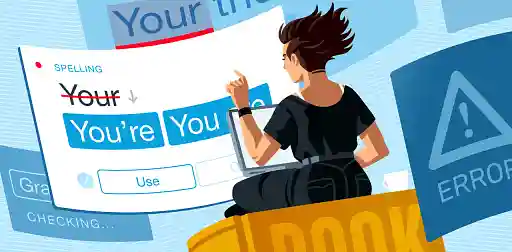






8 responses
Sasha Winslow says:
14/05/2019 – 02:56
I started writing in February 2019. It was random, but there was an urge to the story I wanted to write. At first, I was all over the place. I knew the genre I wanted to write was Fantasy ( YA or Adult). That has been my only solid starting point the genre. From February to now, I've changed my story so many times, but I am happy to say by giving my characters names I kept them. I write this all to say is thank you for this comprehensive step by step. Definitely see where my issues are and ways to fix it. Thank you, thank you, thank you!
Evelyn P. Norris says:
30/10/2019 – 14:18
My number one tip is to write in order. If you have a good idea for a future scene, write down the idea for the scene, but do NOT write it ahead of time. That's a major cause of writer's block that I discovered. Write sequentially. :) If you can't help yourself, make sure you at least write it in a different document, and just ignore that scene until you actually get to that part of the novel
Allen P. Wilkinson says:
28/01/2020 – 04:51
How can we take your advice seriously when you don’t even know the difference between stationary and stationery? Makes me wonder how competent your copy editors are.
↪️ Martin Cavannagh replied:
29/01/2020 – 15:37
Thanks for spotting the typo!
↪️ Chris Waite replied:
14/02/2020 – 13:17
IF you're referring to their use of 'stationery' under the section '1. Nail down the story idea' (it's the only reference on this page) then the fact that YOU don't know the difference between stationery and stationary and then bother to tell the author of this brilliant blog how useless they must be when it's YOU that is the thicko tells me everything I need to know about you and your use of a middle initial. Bellend springs to mind.
Sapei shimrah says:
18/03/2020 – 13:59
Thanks i will start writing now
Jeremy says:
25/03/2020 – 22:41
I’ve run the gamut between plotter and pantser, but lately I’ve settled on in-depth plotting before my novels. It’s hard for me to do focus wise, but I’m finding I’m spending less time in writer’s block. What trips me up more is finding the right voice for my characters. I’m currently working on a sci-fi YA novel and using the Save the Cat beat sheet for structure for the first time. Thank you for the article!
Nick Girdwood says:
29/04/2020 – 10:32
Can you not write a story without some huge theme?